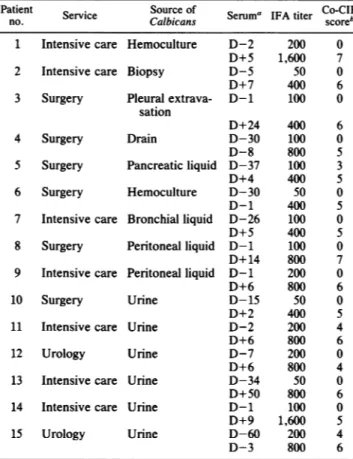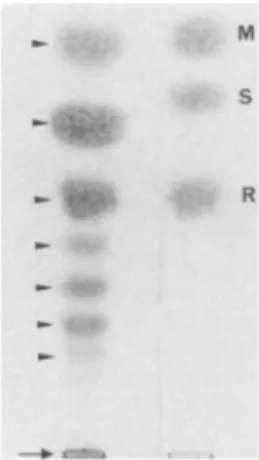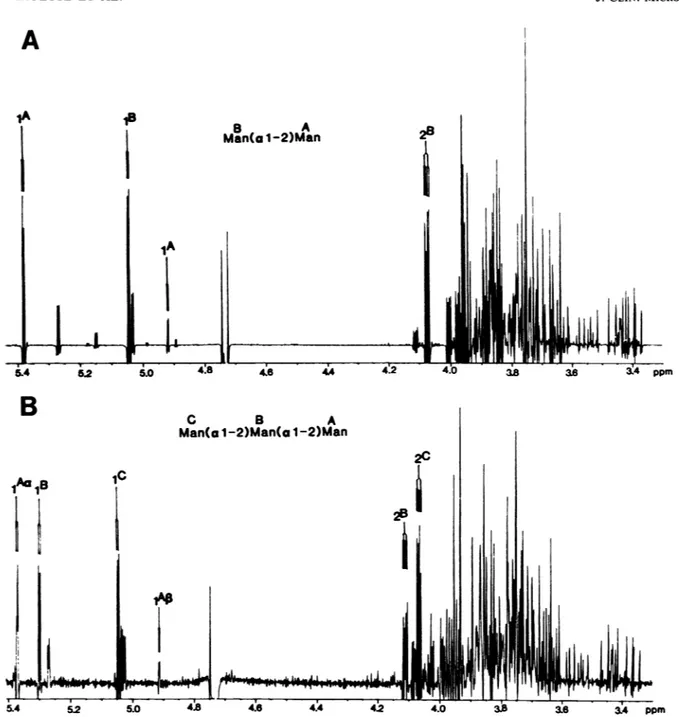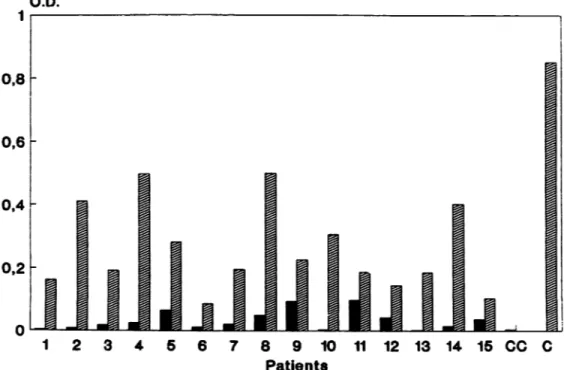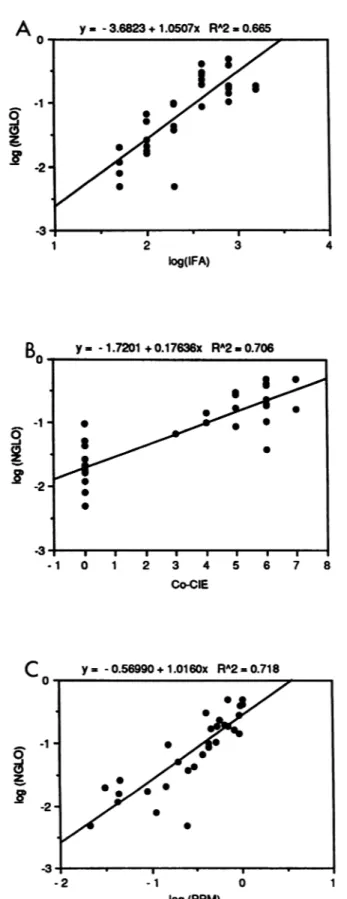0095-1137/92/020411-07$02.00/0
Copyright © 1992, AmericanSociety forMicrobiology
Presence of Human
Antibodies
Reacting
with
Candida albicans
O-Linked
Oligomannosides
Revealed
by
Using
an
Enzyme-Linked
Immunosorbent Assay and
Neoglycolipids
MARIE PIERRE
HAYETTE,1
GEIRARD STRECKER,2 CHRISTINEFAILLE,'
DANIELDIVE,'
DANIEL
CAMUS,1
DONALDW. R.MACKENZIE,3
AND DANIEL POULAINl*InstitutNational de laSante etdelaRechercheMedicale, Unite42, Domaine du CERTIA,
369,
rueJ. Guesde.BP39,1 and Laboratoire de Chimie Biologique etUnite Mixte111 CNRS, Universite des Scienceset Techniques
de LilleFlandres-Artois,259650 Villeneuve
d'Ascq,
France, andMycological
Reference
Laboratory,Central Public HealthLaboratory Service, LondonNW95HT, United Kingdom3
Received 24July1991/Accepted 24 October 1991
In order to study the presence of antibodies directed against Candida albicans 0-linked oligomannosides (oligomannosides 0) in patient sera, we have developed an enzyme-linked immunosorbent assay (ELISA)
involvingneoglycolipids constructed with these residues (NGLO). Oligomannosides 0 released bymildalkaline degradation of the C. albicans cell wall phosphopeptidomannan (PPM) contained one to seven mannose residues,among which thequantitativelymajorcomponents, mannobiose andmannotriose,wereshownby
'H
nuclearmagnetic resonance to contain exclusivelya(1-2)linkages. The poolofoligomannosides was converted
to neoglycolipids by coupling them to 4-hexadecylaniline in an equimolar reaction checked by thin-layer
chromatography. We have tested against these neoantigens, coated on ELISA plates, 15 pairs of sera
corresponding to individual seroconversions observed in 15 patients duringthe course ofa mycological and serological survey of candidiasis. For allpatients,seroconversions resulted in an increased level of antibodies against NGLO. A significant correlation was observed between the results ofELISA-NGLO,ELISAinvolving
the original PPM molecule, and routine antibody detection tests, indirect immunofluorescence assay, and
cocounterimmunoelectrophoresis. These results therefore demonstrate the synthesis of human antibodies
reactive witholigomannosides 0 constitutive of the C. albicans mannan molecule which have been previously described asexhibiting an inhibitory effecton humanlymphocytic proliferation.
Candidaalbicans mannanpolysaccharide isamajor com-ponent of the cell wall whose
importance
in the physiopa-thology of candidiasis has been the subject of extensivestudies. It has been shown that mannans determine the
antigenic specificity of Candida species and C. albicans
serotypes as analyzed with polyclonal-adsorbed antibodies
(11, 29). Antimannan antibodies are present in the seraof
most healthy individuals (2) and show an increase during
development of invasive candidiasis in immunocompetent
patients (15). Furthermore, antimannan polyclonal (1) or
monoclonal (10, 19) antibodies allow the detection of anti-genemia inserafrom patients with systemic Candida infec-tion.
Finally,
bioclinicalandexperimental evidence indicates thatmannan isapotentimmunomodulator(4).Recentrefinementsinmethods forfractionationand struc-turedetermination have ledtothedescription ofamodelfor thestructureof these cellwallmatrixcomponents extracted
by autoclaving and corresponding to
phosphopeptidoman-nan (PPM) (12, 25, 26). The polysaccharide moiety of the
PPM molecule is linked to the peptide via asparagine
(N-glycosidepart) andserineorthreonine residues(O-glycoside
part). The N-glycoside part is composed of a highly
branched chain of mannopyrannosyl residues linked by
a(1-6) bonds to which are attached oligosaccharide side
chains,
where mannopyrannosylresidues arelinkedthroughot(1-2),a(1-3),
P(1-2), P(1-6),
andphosphodiester bonds (7, 8,12, 14). The
O-glycoside
component appears to consist ofshorterandunbranched chains (18).
* Correspondingauthor.
Experimental evidence indicates that individual oligoman-nosides obtainedby depolymerization of the PPM molecule representepitopes which have been described as the basis of
rabbit polyclonal-antibody specificities (7, 28). These con-clusions were reachedby applicationofinhibition reactions in liquid phase (7, 8, 17). These techniques, which are not
welladaptedtothemultivalent character of immunoglobulin
M (IgM),the predominant isotype against polysaccharides, require large quantities of purified oligomannosides and are
poorly adapted to extensive screenings. At the moment,
becauseof the lack ofappropriate methodology,recognition
by human antibodies of the C. albicans oligomannoside
repertoire present in the mannan molecule is virtually
un-known. We have recently developed a method to render
oligomannosides antigenic by coupling them to a carrier
molecule abletobind to aconventional substrate for
immu-noanalysis (Sa, 6). The oligomannosides are coupled to a
lipid, 4-hexadecylaniline, accordingto amethodleadingto a
mole-to-molebindingwhoseefficiencycanbevizualizedand assessed after thin-layer chromatography. The purpose of thisworkwasto usethis methodtodetermine if the 0-linked
oligomannosides,which have beenrecently demonstrated as
exhibiting
aninhibitory effectonhumanlymphocytic prolif-eration inducedbyCandida and otherantigens(18), elicit anantibodyresponseduringinvasive candidiasis.
0-linked oligomannosides, releasedfrom the PPM
mole-culeby ,Belimination, wereanalyzedby thin-layer
chroma-tographyand
'H
nuclearmagneticresonance(NMR)(forthetwomajoroligomannosides)beforebeingconverted to
neo-glycolipids (NGL) containing 0-linked oligomannosides
(NGLO). NGLOwerecoated onplates foranenzyme-linked
TABLE 1. Identification of sera from 15 patients tested with ELISA procedures against PPM and NGLO
Patient Source of Seruma IFA titer Co-CIE
no. Service Calbicans score
1 Intensive care Hemoculture D-2 200 0
D+5 1,600 7
2 Intensive care Biopsy D-5 50 0
D+7 400 6
3 Surgery Pleuralextrava- D-1 100 0 sation
D+24 400 6
4 Surgery Drain D-30 100 0
D-8 800 5
5 Surgery Pancreatic liquid D-37 100 3
D+4 400 5
6 Surgery Hemoculture D-30 50 0
D-1 400 5
7 Intensive care Bronchialliquid D-26 100 0
D+5 400 5
8 Surgery Peritonealliquid D-1 100 0
D+ 14 800 7
9 Intensive care Peritoneal liquid D-1 200 0
D+6 800 6
10 Surgery Urine D-15 50 0
D+2 400 5
11 Intensive care Urine D-2 200 4
D+6 800 6
12 Urology Urine D-7 200 0
D+6 800 4
13 Intensive care Urine D-34 50 0
D+50 800 6
14 Intensive care Urine D-1 100 0
D+9 1,600 5
15 Urology Urine D-60 200 4
D-3 800 6
aIdentificationof sera relates to the date of serumsamplinginrelation to
mycological examination.D, day;+ or-,beforeorafterpositiveculture. bDefined as follows: 0, absence ofprecipitin line; 1, faint, nonspecific precipitinline;2, onenonspecificprecipitinline; 3 to 7, presence of cospecific
precipitinline withincreasingintensities.
immunosorbent assay, and their
antigenicity
wasstudiedby
probing
themwith human sera.These sera wereretrospec-tively
selected fromhospital inpatients
who hadserocon-verted during the course of a mycological and serological
surveyfor candidiasis by indirect immunofluorescence assay
(IFA) and
cocounterimmunoelectrophoresis (Co-CIE)
pro-cedures (20). The results of ELISA-NGLO
appeared
tocorrelate with the results of ELISA
involving
theoriginal
PPM molecule and with results from routine
serological
tests. Construction of NGL has
provided,
for the firsttime,
evidence
for thesynthesis
of antibodiesagainst 0-linked
oligomannosides.
MATERIALS AND METHODS
Strain.Acloned strain ofC. albicans serotypeA(VW32)
wasused throughout this study. It was selected because of
its
high
reactivity against serafrompatients
suffering
from candidiasis(21).Humansera. Details forthese sera are
given
in Table 1.Thirty
seraoriginated from 15patients whowereretrospec-tively
selectedaccording
tobiological
and clinical datacollected in thedepartment of
Parasitology-Mycology
attheUniversity Hospital
of Lille. Thefollowing
selection criteriawere
applied:
(i) patients who had hadC.albicans isolatedatleast once in
large
quantities
fromnormally
sterile sites(including blood, catheter, drain, peritoneal and pleural cavities, biopsies, and pancreatic cyst) orfrom urine sam-ples; (ii) patients with probable invasive candidiasis, based on history and presentation (fever resistant to antibiotics,
response to antifungal therapy); (iii) availability of serial serumsamples forthe corresponding patients takennearthe date of positive cultures anddemonstrating seroconversion
asanalyzed byroutine serodiagnostic procedures (IFA and
Co-CIE; seebelow).Two serawere selected for each ofthe 15 patients: onefrom beforeand onefrom after seroconver-sion. As a positive control (C), we used the serum from a
patient who had presented with C. albicans septicemia
proved by threesuccessive positivebloodculturesand who
exhibited high levels of antibody againstC. albicans.
Routine serological tests. (i) IFA. IFA wasperformed with
C. albicans VW 32 blastoconidia (20). Standardization of
this test was achieved by the use ofa pool ofsera from patients with candidiasis (Bio-Merieux, Marcy l'Etoile, France). A titer equal to or greater than 400 is considered
indicative ofcandidiasis.
(ii) Co-CIE. Co-CIE with a soluble extract of VW 32
blastoconidia was used to detect precipitating antibodies
presenting a line ofidentity withan anti-VW 32 germtube
antiserum (20). This line of identity is named the cospecific
precipitin line (CSPL). Interpretation of Co-CIE results
refers to presence or absence of CSPL and quantitative
evolutionoftheCSPL(migration towards the cathodewhich
increases in intensity for successive sera from the same
patients). Quantification oftheresults obtained by Co-CIE
was needed for statistical analysis, and results were ex-pressed through scores defined as follows: 0, absence of precipitin line; 1, faint, nonspecific precipitin line; 2, one
nonspecific precipitating line;3 to7, presenceof CSPL with increasingintensities.
Obtainment and analysis of 0-linkedoligomannosides. (i) Production of PPM. PPM was extracted from yeast cells
grown in bioreactors accordingto the methoddescribed by
Kocourek and Ballou (13). The procedure was modified in
thatasingle extraction in citrate bufferwas made (6).
(ui)
Mildacidhydrolysis.Accordingtothe methodof Failleetal. (6), 1 gofPPM wasdissolved in 50 mlof HCI(0.01N),
and the solution was heated at 100°C for 30 min. After
cooling, thesolutionwasneutralized withNaOH and lyoph-ilized.
(iii) Mild alkaline hydrolysis. According to a method
adapted from that ofNakajima and Ballou (16), 585 mg of
PPMdepleted ofoligomannosides after mild acidhydrolysis
wasdissolved in50mlof NaOH(0.1 N), incubatedfor24 h at25°C under agitation, and then neutralized with acetic acid
(1 N) andlyophilized.
(iv) Gel filtration chromatography. After each hydrolysis, theproductsweredissolved inwaterand settledonBio-Gel
P4 (Biorad, Herdfordshire, England) columns (1.8 by 150
cm). The columnswereeluted with distilledwater at aflow
rate of 5 ml/h at room temperature. Fractions (2 ml) were
collected and analyzed by thin-layer chromatography.
(v) Thin-layerchromatography. Theoligosaccharideswere
separated on Silica Gel 60-precoated plates (Kieselgel 60,
Merck, Darmstadt, Germany) with n-butanol-acetic
acid-water (20/10/10, vol/vol/vol) as a solvent. The
oligosaccha-rides werestained withasolution of orcinol(2
g/liter)
in20%
sulfuric acid and heated at 105°C for 10 min. NGL were
settled onSilica Gel60F254-precoated
plates (DC
Alufolien60 F254 Kieselgel,
Merck)
andseparated
with chloroform-methanol-water(54/34/9.3, vol/vol/vol)
as a solvent.Lipids
chromatography plates by short-wave (254-nm) UV light. Theglycan moiety was stained by orcinol sulfuric reagent.
(vi)
'H
NMR analysis. The solution of oligomannosides was exchanged several times in D20 with intermediatelyophilization. NMR spectral analysis of the compounds in
D20 (99.95%; Commissariat a l'Energie Atomique, Gifsur
Yvette, France) was carried out on a BRUCKER AM-400
WB Spectrometer operating in the Fourier transform mode
at aprobe temperature of300 K. Chemicals shifts are given relative to sodium 2.2-dimethyl 2-silapentane 5-sulfonate
(indirectly to acetone in D20: 8 = 2.225 ppm). Resolution
enhancement of the
'H
NMR spectrum was achieved byLorentzian-to-Gaussian transformation. Interpretation of
the
'H
NMR spectrum was made according to Cohen and Ballou (3).Construction and analysis of NGLO. Construction and
analysis of NGLOwerecarriedoutaccordingto a previously
described method (6). Briefly, 100 mg of4-hexadecylaniline
(Aldrich Chemical Co., Milwaukee, Wis.)was added to 500
[LI
of a solution containing 35 mg of sodiumcyanoborohy-dride, 3.5 ml of methanol, and 400
RI
of acetic acid. Thesolutionwasheated at80°C,and 1mgof 0-linked
oligoman-nosides solubilized in 50 ,ul of water was added to 200
RI
ofthis solution and incubatedat 80°Cfor 90 min. The solution wascooled, mixed with chloroform and water added in equal parts, and centrifuged. The aqueous phase was dried,
dis-solved in methanol(2ml), andcentrifuged. Thesupernatant
containing theNGLO was conserved.
ELISA procedure. The ELISA involved PPMand NGLO
coatedonto96-wellpolystyrene plates (Nunc Immuno Type
II).
The method was set up, as previously described for a
different pool ofoligomannosides, by analyzing the reactiv-ity of three patient serawith different IFA titers (5a). For
given concentrations ofhuman antibodies and conjugates,
the elevation in optical density (OD) was related to the
quantity ofPPMand NGLOuntilamaximumwasreached.
Wechose for both antigens the carbohydrate concentration
giving the best discrimination between sera with different IFAtiters. Asbefore
(5a),
atthese concentrations of antigenandneoantigen, reactions with antibodies were found as to
be dosedependent and saturable.
Application of these analyses led to the definition of the
following methods as routine procedures. They were used
throughout the study.
For NGLO, each well received 50 ,ul of a 10-,ug/ml
solution of antigen in carbonate buffer (60 mM, pH 9.6).
Plates were incubated for 1 hat 37°C and overnight at 4°C
and then washed five times in TNT buffer (Tris, 50 mM;
NaCl, 150 mM; HCI [pH 7.5]; Tween 20, 0.05%). The last wash was prolonged for 5 min. The plates were stored at
-20°C. All wells were saturated with a bovine serum
albu-min (Boehringer, Mannheim, Germany) solution diluted to
3% in TNT buffer lacking Tween.
50-pI
volume of 1/1,000serum diluted inTNTbufferwasincubated in each well for
1 h at 37°C. After four washes in TNT, 50
pl
of theperoxidase-labeled antibody (goat anti-human
immunoglob-ulinIgG, IgM, and IgA[Biosoft, Paris, France, and Zymed
Laboratories, South SanFrancisco, Calif.]) diluted in TNT
(1/2,000)
was incubatedfor 1 h at 37°C. After five washes inTNT buffer, each well received 100
pI
of the enzymaticsubstrateviaasolutionoforthophenylenediamineat 1g/liter
inTNTbufferwith 0.5
pI
of hydrogen peroxide (30%) per ml.After30minof incubationatroom temperature in the dark,
the reaction was stopped by adding 50
RI
of 4 MH2SO4.
Plates were scanned at 490 nm on amicroELISA reader. The
M
.eas:~~
'"M R
FIG. 1. Thin-layer chromatography ofoligosaccharides released by alkalinedegradation(Pelimination) onPPM depleted in oligosac-charides linked through phosphodiester bondsby mild acid hydro-lysis. Oligosaccharides were desorbed from a Bio-Gel P4 column (1.8 by 150 cm). Seven spots, corresponding to oligosaccharides containing one to seven mannose residues, can be seen. Three controls were used: mannose(M),saccharose (S), andraffinose(R). The arrow at the bottom indicates the pointofapplication. ELISA procedure using PPM antigen coated on ELISA
plates was similar except that (i) plates were coated with 100
,ulof a1-,ug/mlsolution of PPM, (ii) human sera (100,ul)were used at a dilution of 1/8,000, and (iii) peroxidase-labeled
antibody (100 ,u) was used at a dilution of1/1,000.
Statistical analyses. Correlations between results obtained with all serological procedures on the 30 sera were studied after a variable transformation for variance homogeneity (27). The correlation coefficients were analyzed by the t test
(23).
RESULTS
Analysis of oligosaccharides released by mild alkaline deg-radation. Thin-layer chromatography of oligosaccharides released by elimination showed the presence of oligosac-charides with one to seven mannose residues (Fig. 1). The quantitatively major components were mannobiose and
mannotriose.
'H NMR analysis of mannobiose and mannotriose. The NMR spectra of mannobiose and mannotriose (Fig. 2) were assigned by the method of Cohen and Ballou (3). For the mannobiose, the anomeric protons were observed at 8 = 5.043 ppm (terminal mannose B) and 5.378 ppm (reducing mannose A, a anomer) (Fig. 2A). The coupling constants were 1.8 Hz for B and Aa and 1.1 Hz for
AP.
For the mannotriose, the anomeric protons were found to resonate at 5.045 ppm (terminal mannose C), 5.297 ppm (internal mannose B), 5.368 ppm (reducing mannose a), and 4.911 (reducing mannoseP)
(Fig. 2B). The coupling constantobserved for the C, B, and Aa signals was 1.8 Hz, which
confirms the a anomery. The results confirmed the structure of the two 0-linkedoligosaccharides as Man(al-2)Man and
Man(al-2)Man(al-2)Man.
Analysis of NGL. The pool of NGLO was analyzed by thin-layerchromatography. Individual components were vi-sualized either under UV light, according to their lipid moieties (Fig. 3), or after orcinol staining according to their carbohydrate moieties (data not shown). Seven bands were identified. They were interpreted as resulting from the mi-gration of Mannose-4hexadecylaniline to
Mannohexaose-A
Man(a1-2)Man
B C B A
Man(a1-2)Man(a 1-2)Man
1Aa
i1l
'"In"
1M
1,.
l0-c
2C
21,-L
5.4 52 5.0 4.8 4:6 4.4 42 4.0 3B 3. 34 ppmFIG. 2. 'HNMRspectraof the twoquantitavely major oligomannosides released from C. albicans after,3elimination:mannobiose (A) and mannotriose(B).
4hexadecylaniline,
with two bands for the Mannobiose-4hexadecylaniline.Human humoral response against NGLO analyzed by ELISA. (i)Analysis of individual responses. When serafrom
individual patients were allowed to react against NGLO,
seroconversion, asrevealedagainst C. albicansantigensby
the routine serological procedures (Table 1), corresponded to an increaseofthe ELISAsignal against NGLO (Fig. 4).
Strong differences were observed in the intensity of the
ELISA signal between individual patients either before or
after seroconversion. The OD forsera drawn before
sero-conversion were usually very low, ranging from 0.005 to
0.098, whereasthe OD for sera taken after seroconversion
ranged from 0.086to0.499. Thelevels ofboth ELISAsignals
were apparently irrelevant to the
mycological
data.How-ever, an increasein OD against the neoantigenwas system-atically observedforanycouple ofsera, eachpatient being
hisown control, confirmingtheantigenicity of NGLO.
(ii) Statistical analyses ofserological tests. Variable trans-formation for variancehomogeneity in relationtoIFA titers led us to express the results of all serological tests except Co-CIEbytheirlogarithms. Linearregression analysis(Fig.
5) demonstrated the existence of a correlation between ELISA-NGLO and IFA (Fig. 5A), Co-CIE (Fig. 5B), and ELISA-PPM (Fig. 5C). The significance of all correlations was greater than 0.001. The coefficient correlation squares wererespectively 0.665,0.706, and0.718,indicatingthat66, 70, and 71% of variation in OD values against NGLO related to variations in serological tests involving "natural" C. albicansantigens.
V.-
m-I -9 1-l .11I-01-A-I
1-II
,it
M4_
m
5-
M6-FIG. 3. Thin-layer chromatography of NGL constructed by cou-pling oligosaccharides released by 13 elimination to the 4-hexadec-ylaniline. The NGL are revealed under UV light (254 nm) according totheir lipid moiety. The arrow at the bottom indicates the point of application. Abbreviations: L, uncoupled lipid; coupled sugars mannose (M),mannobiose (M2), mannotriose(M3),mannotetraose (M4),mannopentose(M5), and mannohexaose (M6).
DISCUSSION
C. albicans cell wall PPM is a molecule which has been
extensively studied from chemical(12, 14,24-26) and immu-nological (4, 5, 7, 8, 18, 28) points of view. The final goal of
such studies is to define relationships between molecular
structure and immunoreactivity. However, because of the lack of methodologies suitable for extensive screenings, no
dataare available concerningthe molecularbasis of human
antibodyresponse.Studies concerning the immunoreactivity
O.D.
1
0,8
0,6
0,4
0,2-0
of the C. albicans oligomannoside repertoire arepresently
restrictedtoantisera studied in highly specialized laborato-ries able to produce and analyze large quantities of
oligo-mannosides (7). Faced with this problem,we haverecently
developed a method of construction of NGL from
oligoman-nosides released bysequentialdepolymerization ofthe PPM.
Suchneoantigens have been shown inexperimental models
to exhibit immunogenicity and antigenicity (6), mimicking the activity of C. albicans natural antigens. NGL coated on
ELISA plates have also been shownto react with
mamma-lian polyclonal or monoclonal immunoglobulins reacting
with the original PPM, according to dose-dependent and
saturable reactions(5a).
Inthe present work, this method has been applied to the
study of human antibodies ableto react with thefamily of
oligomannosides linkedtothePPMmoleculeby O-glycoside
linkages and releasedafter ,3 elimination (16). Mild alkaline
degradation ofC. albicans mannan,previously depleted in
oligomannosides attached through phosphodiester bonds,
led to the release of 0-linked oligomannosides containing
one to seven mannose residues. The structural
determina-tion of the majoroligomannosides, mannobiose and
manno-triose, demonstrated the presenceof (al-2) linkages.These
resultsaresimilartothose obtainedby Podzorskietal.with
another C. albicans strain (18), except that those authors
described only sixoligomannosides. Thin-layer
chromatog-raphy analysis of oligosaccharides after theywerecoupledto
4-hexadecylaniline allowed the efficiency ofthebindingto be
visualized and assessed. Eachcoupled oligomannoside
ex-cept the mannobiose appeared on the chromatogram as a
single band; the mannobiose gave two bands. The most
likely hypothesis to explain this observation would be
re-lated to the aglycone part of NGL, the aqueous solvent
triggering two differentionizations. This phenomenon
hap-1
2
3
4
5
6
7
8
9
10
11
12
13
14
15 CC
C
Patients
FIG. 4. Human serumreactivity against NGLO as analyzed by ELISA. Results are expressed as OD for each pair of sera drawn from the
15selectedpatients. Sera drawn before seroconversion are represented by black bars, and sera drawn after seroconversion are represented by hatched bars. Numbers under the abscissa refer to patient numbers as identified in Table 1. CC, conjugate control; C, positive serum control.
IN -'II P.'
L
-:,--..-Iz-,.'...,.,-A,.
y- -3.6823+1.0507x RA2 0.665 0 z F 2 log(IFA)6-1
y= -1.7201 +0.17636x RA2 O.Q706 Co-CIE 0 z C y 0-.56990+1.0160x RA2=0.718 -2 -1 0 1 log(PPM)FIG. 5. The graphs represent the relations between serological
results given by ELISA-NGLO and IFA (A) Co-CIE (B), and ELISA-PPM (C). All the dataexcept thosefor Co-CIEwere used after variable transformation. The curve's equations are noted on the top of each graph; R2 is the coefficient correlation square relating the twovariables.
penedonly for coupled mannobiose, the other
oligommano-sides being too heavy to be separated on thin-layer chro-matograms according totheir ionization patterns.
Despite the fact that an immunomodulatory role ofC.
albicans 0-linked oligomannosides against human
lympho-cytic proliferation induced in vitro (18) has been
demon-strated,itwas notknownifthese structures could react with
antibodies. From a physiopathological point of view, the
existence of antibodies reacting withthese oligomannoside species is an important consideration, since the antibodies may interfere with the direct triggering of lymphoid cells
induced by these potential epitopes. The demonstration of
the existence of human antibodies able to react with
0-linked oligomannosides through conventional methods of
precipitation inhibition is in practiceunrealizablebecauseof the amount of oligomannosides required for such experi-ments(7, 17). Consideringthislack of methodologyadapted to extensivescreenings of C. albicans oligomannoside reac-tivity with human and animal antibodies, wehave recently developed a method for constructing NGL from these
resi-dues. Followingapplicationof thismethod,oligomannosides
from various families (5a, 6) have been shown to bind to conventional substrates for immunoanalysis through their
lipid carrier molecule and to be able to reactwithantibodies
according to dose-dependent and saturable reactions (5a). Construction of NGL from C. albicans 0-linked
oligoman-nosides provided, for the first time, evidence of human antibodies reactingwith these residues. Evidence came both from increased ELISA-NGLO signals following individual
seroconversions and from the close correlation observed
betweenreactivity of sera againstNGLO andPPM. Despite individual differences, whose diagnostic and prognostic sig-nificance remains presently unclear, reactivity of patient
sera against neoantigens evaluated as a whole did not
significantlydiffer from that against the PPM fromwhichthe neoantigens werederived. Theseresultsarecompatible with
what is known about the structure of0-linked
oligomanno-sides composed of Man a (1-2) and Man a (1-3) linkages
largely distributed through the N-linked part of the PPM molecule(24); in the sameway, the use of PPM depletedin 0-linked oligomannosides did not significantly affect PPM reactivity against patient sera (unpublished data). It is also consistent with the experimental evidence reported by
Shi-bata et al. (26) that, in contrast to mild acid hydrolysis,
P
elimination did not affectthe precipitating effect of
antibod-ies raisedagainstdifferent C. albicans serotypes.Therefore,
according to this lackofstructural specificity ofC. albicans
0-linked oligomannosides, it is impossible at the present stage ofthis work to say if the antibody response
demon-strated here resulted from specific triggering of the human immune system by these molecules or represented cross-reactivity with antibodies generated against similar struc-tures by otheroligomannoside species of the mannan mole-cule.
Theacknowledged risk of ourimmunochemical approach,
which also exists with the precipitation inhibition reactions
in liquid phase used as areference (7), is that neoantigens
could suffer chemical alterations during preparation proce-dures sothat theirconformationwould notmimicthe natural
antigen. In this respect, the correlation observed between
the ELISA-PPMand ELISA-NGLO has beenencouraging.
As an incidental finding, statistical analysis revealed no
interference between the results obtained and antigenemia,
asrevealed by the Cand-tectest (9) inserafrom 12patients
(datanotshown). Despite slightdifferences between
werecompared twoby two afteranadapted variable
trans-formation, agood overall correlation was nevertheless
ob-served between them. This is not surprising, since all these tests detect antibodies against C. albicans mannoproteins according to their precipitation with a whole-cell extract (20), theirreactivity with the cell wallsurface (22), ortheir reactivity with the PPM extracted from the surface and deeper layers of the cell wall (21). Construction of NGL therefore provides a way for the determination ofthe mo-lecular basis of the human antibody response against cell wall mannan, which has sofar been appreciated as a whole. This analysis is currently being extended to other oligoman-noside families to determine the prognosis and diagnostic significance of their recognition by human immunoglobulin isotypes.
ACKNOWLEDGMENTS
This work was supported by the Institut National de la Santd et de la RechercheMddicale,the Centre National de la Recherche Scien-tifique (CNRS, Unite mixte 111; Relations structure-fonction des constituants membranaires; Directeur, J. Montreuil), and the Fon-dation pourlaRecherchemddicale.
We are grateful to J. M. Wieruszelski for recording the NMR spectra and to G. Lepage and A. Bernigaud for their valuable technical assistance.
REFERENCES
1. Bailey, J. W., E. Sada, C. Brass, and J. E. Bennett. 1985. Diagnosis of systemic candidiasis by latex agglutination for serum antigen. J. Clin. Microbiol. 21:749-752.
2. Chew, W. H., and T. L. Theus. 1967. Candida precipitins. J. Immunol. 98:220-224.
3. Cohen, R. E., and C. E. Ballou. 1980. Linkage and sequence analysis of mannose-rich glycoprotein core oligosaccharides by proton nuclear magnetic resonance spectroscopy. Biochemistry 14:4345-4358.
4. Domer, J. 1989. Candida cell wall mannan: a polysaccharide with diverse immunologic properties. Crit. Rev. Microbiol. 17:33-51.
5. Durandy, A., A. Fischer, D. Charron, and C. Griscelli. 1986. Specific binding of antigen onto human Tlymphocytes. J. Clin. Invest. 77:1577-1587.
5a.Faille,
C. Submitted for publication.6.
FailHe,
C., J. C.Michalski, G. Strecker, D. W. R.Mackenzie, D. Camus, and D. Poulain. 1990. Immunoreactivity of neoglycolip-ids constructed from oligomannosidic residues of the Candida albicans cell wall. Infect. Immun. 58:3537-3544.7. Fukazawa, Y. 1989. Antigenic structure of Candida albicans, p. 37-62.In E. Kurstak, G. Marquis, P. Auger, L. de Repentigny, and S. Montplaisir (ed.), Immunology of fungal diseases. Marcel Dekker, Inc., New York.
8. Fukazawa, Y., A. Nishikawa, M. Suzuki, and T. Shinoda. 1980. Immunochemical basis of the specificity of the yeast: immuno-chemical determinants of several antigenic factors ofyeasts, p. 126-136. In H. J. Preusser (ed.), Medical mycology. G. Fisher, Stuttgart, Germany.
9. Gentry, L.O., I. D.Wilkinson, A. S. Lea, and M. F. Price. 1983. Latex agglutination test for detection of Candida antigen in patients with disseminated disease. Eur. J. Clin. Microbiol. 2:122-128.
10. Georges, E., M. L. Garrigues, J. L. Poirot, J. P. Massini, and M. C. Meyohas. 1991. Diagnostic des candidoses systemiques par un test au latex. Rdsultatsd'uneanndede suiviserologique chez les malades a risques. J. Mycol. Med. 118:25-28. 11. Hasenclever,H. F., and W. 0.Mitchell. 1961. Antigenic studies
of Candida. Observation of two antigenic groups in Candida albicans. J. Bacteriol. 82:570-573.
12. Kobayashi, H.,N.Shibata,H.Mittobe,Y.Okubo, and S. Suzuki. 1989.Structuralstudyofphosphopeptidomannanofyeast-form cellsof Candida albicans J-1012 strain, with special referenceto
application of mildacetolysis. Arch. Biochem.Biophys. 72:364-375.
13. Kocourek,J.,andC.E.Baflou.1969. Method forfingerprinting yeastcell wallmannans.J. Bacteriol. 100:1175-1180.
14. Kogan, G., V. Paviiak,and L.Master. 1988.Structural studies of mannanof the cell wall of pathogenic yeastCandida albicans serotypes Aand Band Candidaparapsilosis. Carbohydr. Res. 172:243-253.
15. Lehman, P. F., and E. Reiss. 1980. Comparison by ELISA of serum anti-Candida albicans mannan IgG levels of normal population and in diseasedpatients. Mycopathology 70:89-93.
16.
Nakajima,
T., and C. E. Ballou. 1974. Characterization of the carbohydrate fragments obtained from Saccharomyces cerevi-siae mannan by alkaline degradation. J. Biol. Chem. 249:7679-7684.17. Okubo, Y., T. Ichikaya, and S. Suzuki. 1978. Relationship between phosphate contentand immunochemical properties of subfractionsof baker's yeast mannan. J. Bacteriol. 136:63-68. 18. Podzorski, R. P., G. R. Gray, and R. D. Nelson. 1990. Different
effects of Candida albicans mannan and mannan-derived oli-gosaccharides on antigen-stimulated lymphoproliferation in vitro. J. Immunol. 144:707-716.
19. Poulain, D., A. Ayadi, and J. Fruit. 1987. Ddtection d'un
antigene temoin d'infectionsystemiqueACandida AI'aide d'un anticorps monoclonal couple A l'or colloidal. Ann. Biol. Clin. 45:565-577.
20. Poulain, D., J. Fruit, L. Fournier, E. Dei Cas, andA. Vernes. 1986. Application ofco-counterimmunoelectrophoresis to the diagnosis of systemic candidiasis. Importance andlimitation of the method. Eur. J. Clin. Microbiol. 5:427-434.
21. Poulain, D., V. Hopwood, and A. Vernes. 1985. Antigenic variability of Candida albicans. Crit. Rev. Microbiol. 12:223-270.
22. Poulain, D., G. Tronchin, J. F. Dubremetz,and J.Biguet. 1978. Ultrastructureof the cell wall of Candida albicans blastospores: study of its constitutive layers by the use of a cytochemical technique revealing polysaccharides. Ann. Microbiol. (Inst. Pasteur) 129:141-153.
23. Schwartz, D. 1989. Test d'independance entre deux variables quantitatives, p. 207-223. In Flammarion (ed.), Methodes statis-tiques A l'usage des medecins et des biologistes, 9eme ed., Imprimerie Nouvelle, Saint-Jean-de-Braye, France.
24. Shibata, N., S. Fukazawa, H. Kobayashi, M.Tojo, T.Yonezu, A. Ambo, Y. Ohkubo, and S. Suzuki. 1989. Structural analysis of phospho-D-peptidomannan-protein complexes isolated from yeast and mold form cells of Candida albicans NIH A-207 serotype A strain. Carbohydr. Res. 187:239-253.
25. Shibata, N., T. Ichikawa, M. Tojo, M. Takahashi, N. Ito, Y. Okuo, and S. Suzuki. 1985. Immunochemical study on the mannan of Candida albicans NIH A-207,NIHB-792 and J-1012 strains prepared by fractional precipitation with cetyltrimethy-lammonium bromide. Arch. Biochem. Biophys. 243:338-348. 26. Shibata, N., H. Kobayashi, M. Tojo, and S. Suzuki. 1986.
Characterization ofphosphopeptidomannan-protein complexes isolated from viable cells of yeasts and mycelial forms of Candida albicans NIH B-792 strain by theaction ofzymolyase 100-T. Arch. Biochem. Biophys. 251:697-708.
27. Snedecor, G. W., and W. G.Cochran.1967. Statistical methods, 6th ed., p. 325-330. Iowa StateUniversity Press, Ames. 28. Suzuki, M., and Y. Fuzakawa. 1982. Immunochemical
charac-terization of Candida albicans cellwallantigens: specific deter-minant of Candida albicans serotype A mannan. Microbiol. Immunol. 26:387-409.
29. Tsuchiya, T., Y. Fukazawa, M. Tagushi, T. Kase, and T. Shinoda. 1974. Serologic aspects onyeastclassification. Myco-pathol. Mycol. Appl. 53:77-85.
